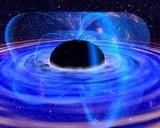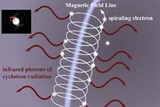Are super-magnetic fields competing companions of Black Holes?
Astrophysicists at Göttingen detect mega-magnetic field

Black Hole, NASA, artist's rendition
There's one of these monsters to be found at the center of almost every galaxy: a supermassive Black Hole, known for its fatal attractive force. Matter which comes too close to the Black Hole tumbles straight into its orbit and is sucked up by it. But it seems now that every Black Hole may have another, also very attractive, companion.
The existence of such magnetic fields could explain why so much of the matter which happens to enter into the surroundings field of a Black Hole still manages to escape. Could the magnetic field be in competition with the Black Hole?

In order to better understand the physics of the Quasar, the scientists put to use, in addition to the Hubble space telescope and to giant optical telescopes in Texas and South Africa, the largest X-Ray satellite of the European space agency ESA, XMM-Newton, which they focused onto the Quasar for an extremely long time of exposure of ten hours. This is how they were able to capture the object for the first time in the X-ray range and to confirm that PG0043+039 belongs into the general class of the Quasars.
„This Quasar is unusual in that, despite its really huge luminosity, it had not been able to be captured in the X-ray range,” according to Prof. Kollatschny. Supermassive Black Holes are to be found in the centre of almost all galaxies. In the so-called active galaxies – for example, in Quasars – matter is subjected to extreme acceleration and heat as it is falling into the centre. This produces in the immediate surroundings of the Black Hole extreme luminosity such as occurs nowhere else in the universe. This radiation can normally be verified in all ranges of frequency from radio- to X-rays.
Thanks to ist very own mega-gravitational forces, the Black Hole attracts all particles – and in it's immediate orbit, the so-called accretion-disk. Then the matter disappears into the Black Hole never to be seen again. Or almost never. Some of it manages to escape it's force of attraction and finds itself catapulted into space in the form of rays of particles, the so-called jets. How this is functioning, astronomers have not been able to determine precisely up to now. It had been conjectured that very strong magnetic fields must be playing a role. They could deviate some of the matter and expel it from the accretion-disk. This makes the new proof just brought by the Göttingen scientists the more interesting. The cyclotron lines demonstrate show clearly, according to Prof Kollatschny, that in Quasar "PG0043+039" a supermassive Black Hole and super strong magnetic field are in direct proximity. For the scientists, this could help throw a little more light into the dark processes taking place around Black Holes.
translated and adapted by Anne-Marie de Grazia
Sources:
University of Göttingen - press-release (04.26.2015)
Nord Deutscher Rundfunk, News

